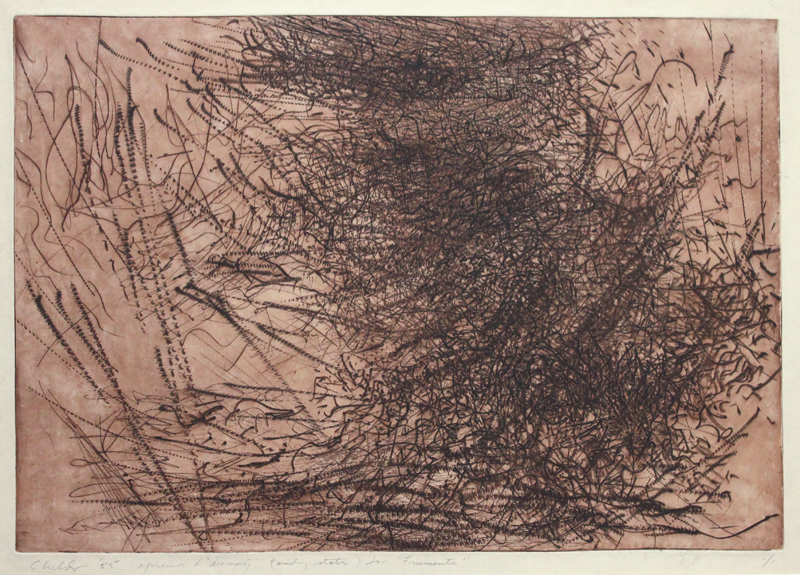Frumenti is color intaglio, a power engraving, printed in 1955 by American artist Bernard Childs (1910-1985). This impression is pencil signed and dated and inscribed épreuve d’essai (only state) for “Frumenti” 1/1. This unique proof was printed by the artist in reddish brown ink on a sheet of cream wove paper. The dimensions are 13-1/4 x 19-3/8 inches platemark.
Frumenti was published in November 1956 by the International Graphic Arts Society in their series no. 21. James Fitzsimmons wrote the following response to Frumenti: “There are three things I would like to note about Childs’ work. He uses line as others use modulations of the voice to communicate nuances of feeling. He brings to his work a painter’s organic sense of color. He is not content to perform beautifully, like a ballet dancer, but has something to say. I think he is making landscapes—“Abstract”, interior landscape, to be sure—where the same interplay of forces may be discerned as in the world around, and the same breath of life animates the lines.”
Judith Childs wrote the following regarding this color intaglio:
You might like to know that after the opening of his 1952 exhibition at the Galeria dell'Obelisco in Rome, an exhausted Bernard was driven by friend to the hills above Rome. In those days, the hills were filled with wheat fields: Frumenti.
Bernard Childs met the Danish silversmith Peer Smed and later remarked: “From this great craftsman I learned the beauty of metals, the feel of them in my hands, the excitement of fashioning them and the use of the special tools that bring them to life.” He later mastered industrial tools and metalworking while employed as a machinist. Childs moved to Europe in 1951, living for a year in Italy before settling in Paris for the next fifteen years. In 1954, while spending a few months at Atelier 17 in Paris, Childs combined his interest in metal and knowledge of industrial tools to make experimental intaglio prints, using power tools to incise the plates.
Bernard Childs’ work was included in numerous international solo and group exhibitions and is represented in the collections of the Museum of Fine Arts Boston; the Brooklyn Museum, Brooklyn; the Fogg Art Museum and the Fitzwilliam Museum, Cambridge; the Zimmerli Art Museum, Rutgers University, New Brunswick; the Metropolitan Museum of Art, the New York Public Library, and the Whitney Museum of American Art, New York; the Newark Public Library, Newark; the Fine Arts Museums of San Francisco; the Worcester Art Museum, Worcester; the Library of Congress, Washington, D.C.; the Butler Institute of American Art, Youngstown; the Stedelijk Museum, Amsterdam, and the Bibliothèque nationale de France, Paris.



